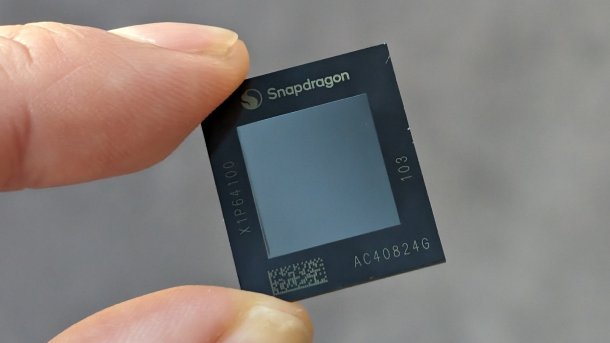Snapdragon X is not just Snapdragon X
Three models of the Snapdragon X Elite are coming, with significant differences in performance. Only the model numbers provide information. The X Plus is new.

A rarity: Qualcomm showed a naked Snapdragon X chip at a pre-event.
(Bild: c't / sht)
Qualcomm announces the "market launch" of the Snapdragon X Plus notebook and tablet processor. For now, however, this only means that PC manufacturers can buy the processor – available devices are not expected until the summer, just like the Snapdragon X Elite.
The Snapdragon X Plus is the little brother of the Snapdragon X Elite, whereby the latter will also be released in three variants. Qualcomm has now confirmed these. The naming is anything but customer-friendly: all three are called Snapdragon X Elite, with only two digits in the eight-digit model numbers drawing attention to the differences. However, these are likely to be hidden in the data sheets of the notebooks and tablets at best.
The differences are sometimes serious. Qualcomm carried out its own benchmarks with the top model "X1E-84-100", which achieves the highest boost clock frequencies of 4.2 GHz. The slowest Snapdragon X Elite "X1E-78-100" has no boost at all, but clocks all 12 CPU cores at a maximum of 3.4 GHz. The mid-range "X1E-80-100" still manages up to 4.0 GHz. This explains the sometimes serious differences in performance in the benchmark databases, such as Geekbench. In purely mathematical terms, the single-threading already drops by 19 percent due to the clock difference.
In the PC world, boosts or turbos are the measure of all things to increase "speed". When starting a program, for example, a processor accelerates a single CPU core within milliseconds so that the application opens faster. This makes systems feel faster. As this only affects one or perhaps two cores, the energy requirement is kept within limits.
| Processor | Cores / Threads | All-Core frequency / max. Boost | GPU | NPU | Memory |
| Snapdragon X Elite | |||||
| X1E-84-100 | 12 / 12 | 3,8 / 4,2 GHz | 4,6 TFlops | 45 TOPS | max. 64 GB LPDDR5X-8448 |
| X1E-80-100 | 12 / 12 | 3,4 / 4,0 GHz | 3,8 TFlops | 45 TOPS | max. 64 GB LPDDR5X-8448 |
| X1E-78-100 | 12 / 12 | 3,4 / - GHz | 3,8 TFlops | 45 TOPS | max. 64 GB LPDDR5X-8448 |
| Snapdragon X Plus | |||||
| X1P-64-100 | 10 / 10 | 3,4 / - GHz | 3,8 TFlops | 45 TOPS | max. 64 GB LPDDR5X-8448 |
Qualcomm is not revealing many details
The slower Snapdragon X Elite and the Snapdragon X Plus presented could primarily be intended for fanless designs. However, this is not certain, as Qualcomm does not reveal the thermal design power (TDP).
A graph merely provides an indication: A reference device with the Snapdragon X Plus draws almost a third less electrical power in the Cinebench 2024 multithreading test than a reference device with the Snapdragon X Elite. However, Qualcomm measures the entire device and not just the processor. Since the system is unknown, no conclusions can be drawn about the TDP.
Qualcomm-Benchmarks zum Snapdragon X Plus (2 Bilder)

(Bild: Qualcomm)
The company presents the Snapdragon X Plus as a particularly efficient model. It presumably uses the same chip as the X Elite, but in a slimmed-down version with ten CPU cores, also without boost. A maximum of 3.4 GHz remains the maximum.
There are virtually no details about the integrated GPUs. Qualcomm only mentions teraflops values – of 3.8 for the Snapdragon X Plus and 3.8 to 4.6 for the X Elite. It is not known how many shader cores are in the Adreno GPUs or what clock frequencies they achieve. According to data sheets, they can encode and decode the modern AV1 codec, for example for YouTube videos.
AI units remain untouched
There are no compromises in the AI unit (Neural Processing Unit, NPU), the last-level caches and the memory connection. All four processor variants, from the Snapdragon X Plus to the fastest X Elite, have an NPU that can perform up to 45 trillion calculations per second (45 TOPS). Up to 64 GB of LPDDR5X-8448 RAM is connected to the 128-bit interface, which can achieve transfer rates of 135 GB/s.
Qualcomm plans to use M.2 plug-in cards with its own chips such as the Snapdragon X65 for 5G mobile communications and Wi-Fi 7. Three USB4 ports are apparently integrated into the processor.
Microsoft apparently wants to use the Snapdragon X Plus in the consumer version of the Surface 10 Pro. This is indicated by Geekbench database entries attributed to the tablet. It remains to be seen whether Microsoft will also release a Surface 10 Pro with the Elite processor or only the Surface Laptop 6. Intel versions will no longer be available.
Empfohlener redaktioneller Inhalt
Mit Ihrer Zustimmmung wird hier ein externer Preisvergleich (heise Preisvergleich) geladen.
Ich bin damit einverstanden, dass mir externe Inhalte angezeigt werden. Damit können personenbezogene Daten an Drittplattformen (heise Preisvergleich) übermittelt werden. Mehr dazu in unserer Datenschutzerklärung.
(mma)